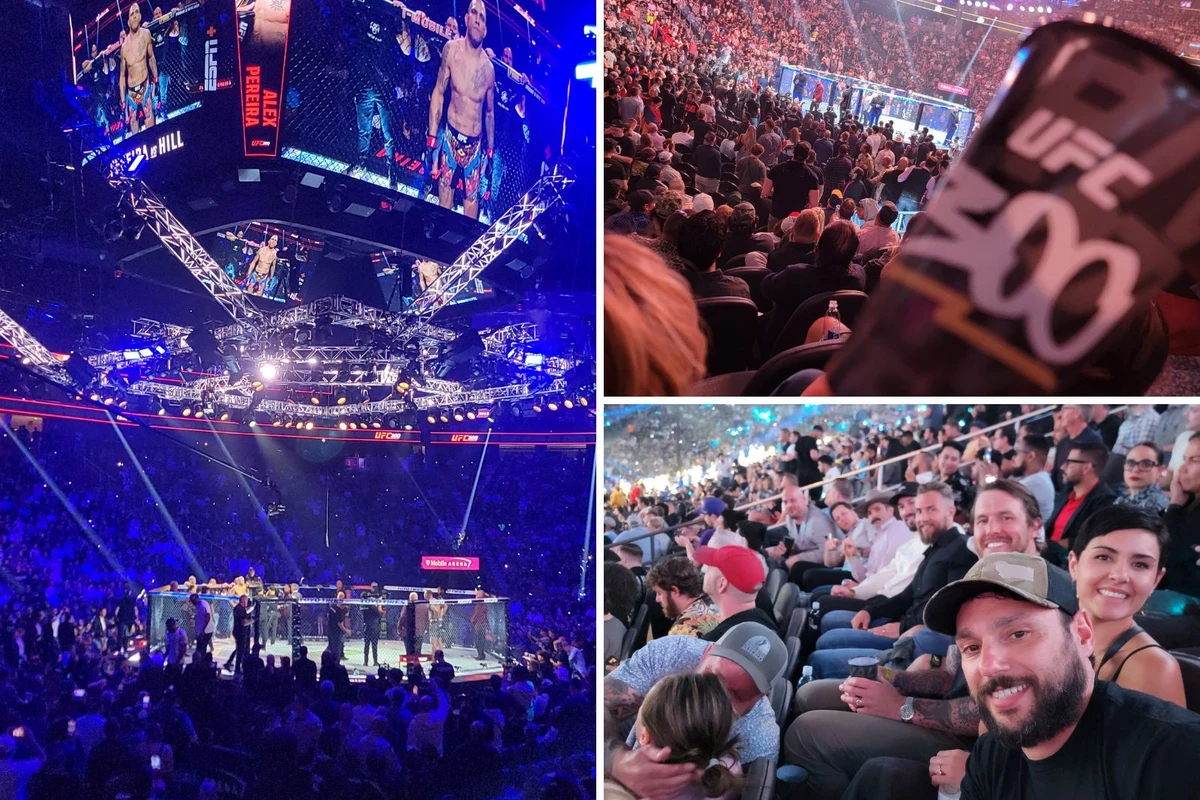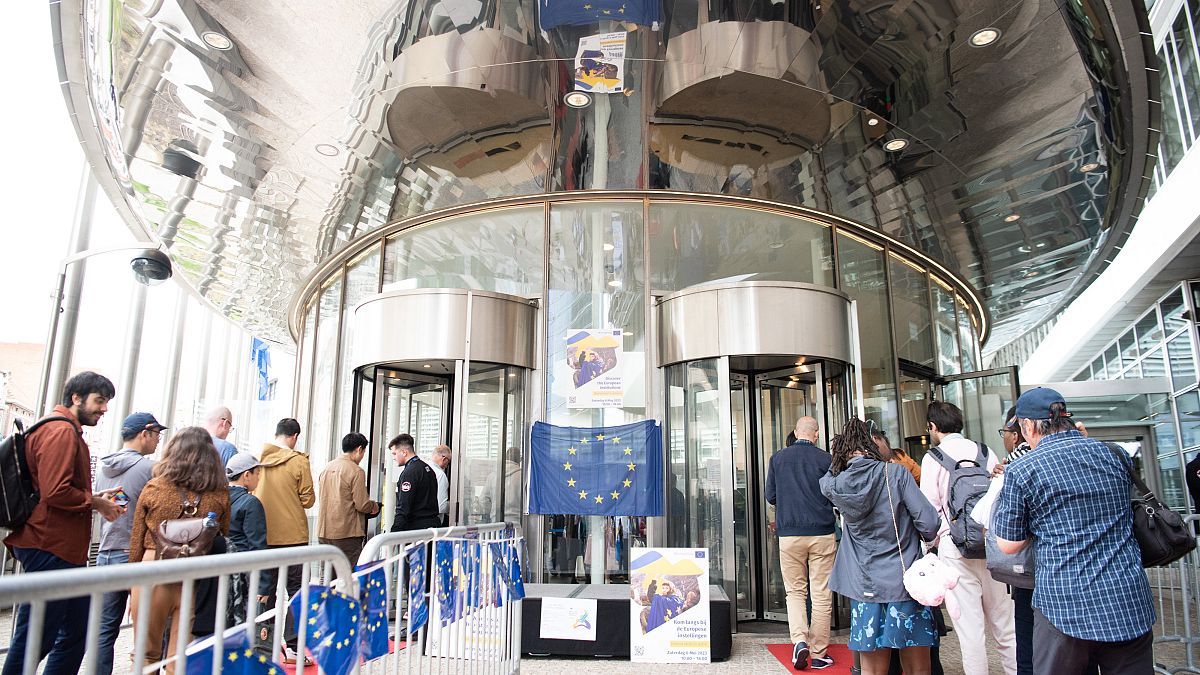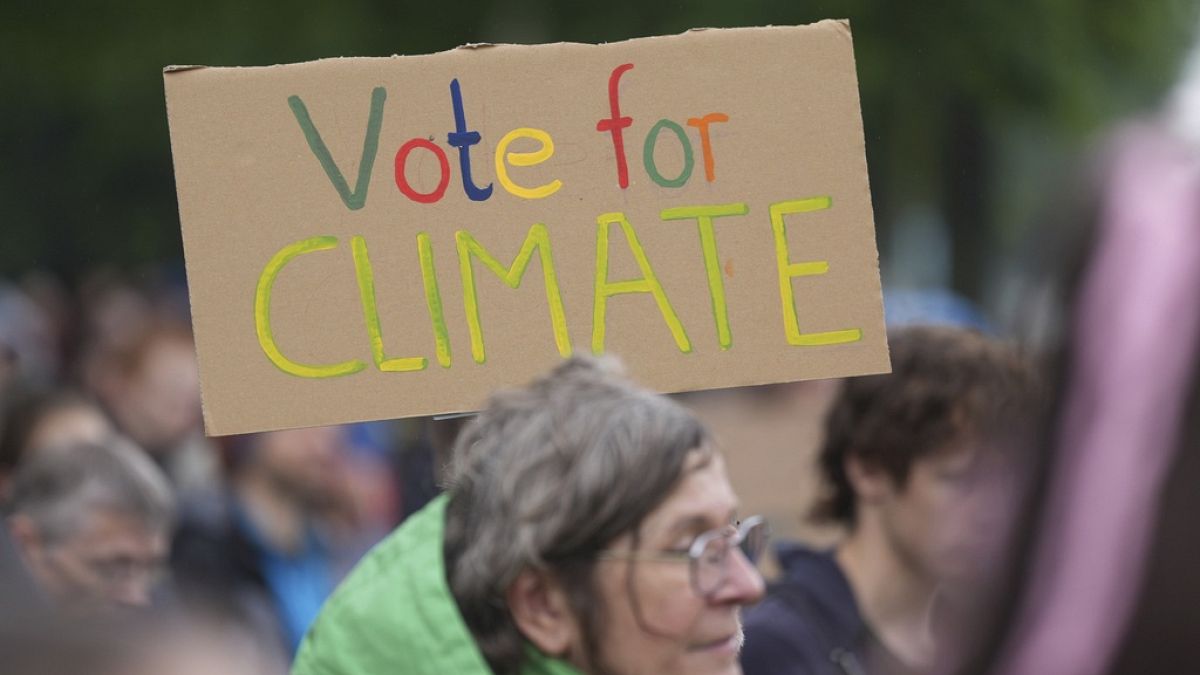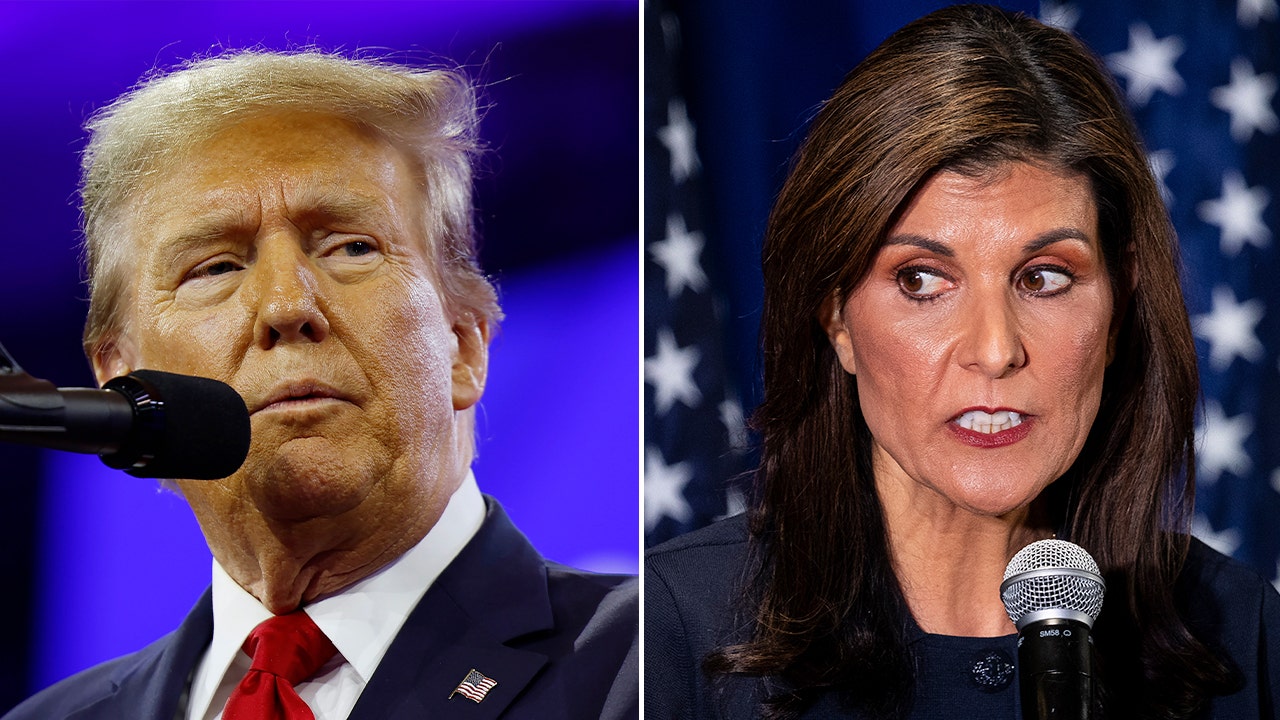Montana
An Epic Trip to UFC 300 in Vegas With a Montana Crew

Our coverage brought to you by the Fusion Fight League. They just had their Fusion Fights in Great Falls- Bozeman and Billings are right around the corner.
My whole family got real excited. I texted them around 6:15 Vegas time Saturday night: “Standing next to Chris Pratt right now.” A few minutes later my daughter texted me that everybody was watching the UFC fight back home in Montana. (They’re all Chris Pratt fans)
I never did say hello to Chris Pratt. He was talking to somebody at the VIP party we got to attend with our friends from the Bozeman-based Anthem Snacks. And then I think he went back to the arena floor shortly thereafter. But I did get to say hi to Green Beret and MMA fighter Tim Kennedy and several others. It was cool seeing Mike Tyson on the arena floor ahead of his much-anticipated fight with Jake Paul this summer too.
I also got to meet Andy Stumpf and the man behind the Montana Knife Company (photo below. Stumpf is a retired Navy SEAL who now lives in Montana’s Flathead Valley and hosts a couple of popular podcasts. In fact, I listened to one episode on the flight down as he interviewed John Nores. (Nores is joining me on the radio again this Tuesday)
The best part of the trip? Aside from the UFC fight itself, it was the incredible group of patriots we got to hang out with down in Vegas. Big thanks to Anthem Snacks CEO Nate Kouhana for letting me tag along on this trip.
Nate Kouhana is a Green Beret veteran. So is Willie Blazer of the legendary Willie’s Distillery in Ennis, Montana. He was on the trip (check out his t-shirt below). Greg Putnam is a Navy SEAL vet who now runs cattle for the Little Belt Cattle Company and volunteers with Warriors & Quiet Waters. Les Craig is an Army Ranger/CIA veteran who works in venture capital in Montana. Dustin Diefenderfer is the founder of MTNTOUGH and is an absolute beast. Ryan Rickert with Fan Up is a great guy. And, of course, Nate’s veteran and military spouse team at Anthem like Paige and Drew are rockstars.
The best fight highlight of the night? Clearly it is this last second knock out by Max Holloway. The whole crowd was on our feet standing in amazement after this one:
On being there in person: I wish I could describe the intensity of the crowd. Electric. Immediate, intense reactions. If you couldn’t see what happened, you’d hear the crowd’s response. The noise was so powerful, it reminded me of when you’re riding a chair lift up a ski hill and you can hear the wind sweep through the trees.
Big thanks also to Willie’s Distillery, Tatanka Cigars (Rocky Mountain Liquor), and Knockout Lifestyle with Corey Willis for sponsoring our UFC coverage!
Read More: A MONTANA LOOK INSIDE THE UFC’S VEGAS PERFORMANCE INSTITUTE
Credit Aaron Flint
Montana Crew at UFC 300 in Las Vegas with Anthem Snacks
A crew of Montanans tagged along with Anthem Snacks, the official jerky of UFC, to attend UFC 300. We also got to get an inside look at UFC’s Performance Institute facility. (This coverage was brought to us thanks to the Fusion Fight League in Montana. Thanks also to Willie’s Distillery, Tatanka Cigars, and Knockout Lifestyle)
Gallery Credit: Aaron Flint

Montana
From his Montana ranch, a retired lawmaker in a crowded House race is angling for a comeback
BILLINGS, Mont. (AP) — From a ranch in one of America’s largest and newest congressional districts, where agriculture and Republicans dominate, a retired six-term Montana lawmaker and grandfather is taking an unlikely path in search of a political comeback.
Former U.S. Rep. Denny Rehberg, 68, is more than a decade removed from a failed U.S. Senate bid.
Now in a crowded field for an open seat without a clear frontrunner, he’s raised little money, hasn’t shown up much on the campaign trail and skipped the only broadcast debate leading up to Tuesday’s Republican primary.
Rehberg jumped into the race after firebrand conservative incumbent U.S. Rep. Matt Rosendale dropped out amid clashes with party leaders.
His opponents suggest Rehberg’s time has passed. And he’s been vastly outspent by opponent Troy Downing, the state’s insurance commissioner, whose donations and loans to his own campaign equal the campaign chests of the other candidates combined.
Election to the House has historically offered Montana politicians a springboard to higher office including U.S. Senate, governor and the White House Cabinet. The district was created following the 2020 Census when population growth earned Montana a second seat in the House.
During an interview at his house on the outskirts of Billings, Montana’s largest city, Rehberg repeatedly held up a book by former Trump administration Interior Secretary David Barnhardt. But he told The Associated Press that unlike former President Donald Trump or Rosendale — who drew backlash for helping oust House Speaker Kevin McCarthy — he’s not a “bomb thrower.”
What to know about the 2024 Election
“If that’s what the people of Montana want, I’m not it,” Rehberg said.
“I want to work within the system,” he added. “And I don’t think that throwing bombs is the best way.”
Rehberg cited his grandchildren and the chance to make a difference in their lives as his motivation for running. He might also be seeking to rehabilitate his image after his bruising last race, said Montana State University political scientist Eric Raile.
“The 2012 U.S. Senate election against Jon Tester was a rough one,” Raile said.
The congressional district sprawls across across more than 100,000 square miles (260,000 square kilometers) of mostly open space from the North Dakota border to Helena. Its voters are overwhelmingly white. About 7% are Native American.
Rehberg, Downing and state schools Superintendent Elsie Arntzen have infused their campaigns with hundreds of thousands of dollars in personal loans as they compete in a seven-way competition that includes state Senate President Pro Tempore Ken Bogner and former state Rep. Joel Krautter, who is backed by a former Republican governor.
Downing, whose loans top $1 million, has also benefited from almost $500,000 in spending on his behalf by a Washington, D.C.-area political group, the Defend American Jobs SuperPAC, that’s funded largely by California-based donors, federal election data shows. He told the AP that he wouldn’t join the conservative Freedom Caucus, as Rosendale did.
“I don’t ever want to be in a position where I am representing a caucus rather than my constituents,” he said.
Arntzen is perhaps the most conservative of the candidates in Montana’s primary.
“Recognizing who Montana is right now means that we are based on Christian faith, we are based on freedoms, we are based very much on local government control and not a top down, heavy mandate,” said Arntzen, who opposes transgender girls participating in girls’ athletics.
Rehberg is optimistic Montana residents will remember him despite his long absence from politics. Since his 2012 loss, Rehberg started and shuttered a string of fast food franchises and lost vision in one eye. His wife Jan — his sole campaign volunteer — drives him at night, Rehberg said.
“My philosophy hasn’t changed since I first ran in 1984. I’m the same person as when I first ran for office,” he said. “A little older.”
___
Hanson reported from Helena, Montana.
Montana
ESPN to Televise Montana vs. UC Davis Football Game in 2024

Missoula, MT (KGVO-AM News) – Part of the afterglow of going all the way to the FCS National Championship Game in January is the fact that ESPN announced this week that it will return to the iconic Washington Grizzly Stadium in November to televise the Montana Grizzlies vs. the U.C. Davis Aggies football game.
I spoke to Eric Taber, UM Athletic Director for Football on Friday about the honor from ESPN.
“This year the ‘Worldwide Leader in Sports’, as they say, is coming to Missoula,” began Taber. “They’re going to be broadcasting the game against U.C. Davis, nationally on one of their three linear TV platforms. So it will be on either ESPN, ESPN 2, or ESPNU. We’re not sure which one yet but the Griz versus Aggies will be on ESPN linear TV and we’re sure excited about that kind of exposure.”
First, it’s a night game and there will be a much larger national audience; and secondly, Taber said the late fall atmosphere will draw a lot of exposure to Washington Grizzly Stadium.
“Early November, that’s a beautiful time in Montana,” he said. “It can be a little hit or miss with the weather, but it should be just a great evening in the stadium. It could be anything from a snowstorm to beautiful fall leaves in the trees around town. It’s just it’s a great time to have ESPN come to town and we’ll hopefully it’s a good game for them as well.”
Taber said all the ESPN platforms are being used to broadcast at least two Big Sky Conference games.
“This is sort of all-encompassing,” he said. “It includes streaming rights, so all of our games are now streamed on ESPN+. Not just football, but soccer games and basketball games, too. “All those games are streamed on ESPN+, that’s part of the agreement with ESPN, and part of that deal was that they would show on linear networks two games from the Big Sky Conference per year regular season games, so they’ve chosen Montana and Montana State to feature this year.”
All Grizzly fans will treasure the memories of the amazing 2023 season.
“I’ve said it many times and I think the only word that really does last season justice is magical,” he said. “It really was just a special season. A special run in the playoffs and you know it had all the ingredients; overtime, double overtime against North Dakota State and it has just all the drama you could ever possibly want to draw up. What a great season to build on, and now we’re on to the next one.”
Montana comes into the summer ranked number 3 in the FCS, while the U.C. Aggies are ranked number 21.
What It’s Like To Journey Through Missoula During A Griz Game
it’s pretty wild to see Missoula just feel completely empty for a couple of hours.
Gallery Credit: Mike Smith
Montana
Climate impact analysis procedures among recommendations in MEPA work group's report • Daily Montanan

The Montana Department of Environmental Quality and Environmental Quality Council might soon analyze climate impacts from energy projects in order to uphold Montanans’ constitutional right to a clean and healthful environment, according to draft recommendations from a workgroup.
The group of 20 people that are looking into ways to clarify and update the Montana Environmental Policy Act was convened in January by the Department of Environmental Quality and consists of lawmakers, energy industry representatives, environmental and conservation groups, tribes, environmental studies experts, and private citizens.
MEPA is a statute passed by Montana lawmakers in 1971 to ensure the legislature is fully considering the environmental impacts of state actions, and is passing laws that uphold the Montana Constitution’s protections of a clean and healthful environment and that the public is informed of them.
The work group’s task is to review how, and if, MEPA should be updated to clarify its role in both protecting the environment and permitting decisions, as well as to try to kickstart methods by which the DEQ can analyze greenhouse gas emissions and climate impacts from projects while the Held v. Montana appeal is decided by the Montana Supreme Court this summer.
Last August, Judge Kathy Seeley found a legislative “limitation” to MEPA, which prohibited the state from considering greenhouse gas emissions or climate impacts when permitting energy and mining projects, was unconstitutional because it violated Montanans’ rights to a clean and healthful environment.
The DEQ released the working group’s 40-page draft report last week, and the full group met Wednesday in what was its second-to-last meeting to discuss the recommendations, voice any dissent, and suggest any final tweaks as the department finalizes the report next week. The full group is set to meet one final time on June 27 to sign off on the report.
“I think we’ve landed on a set of recommendations that really reflected the challenges that I feel in MEPA,” said DEQ Director Chris Dorrington. “I don’t agree with all the recommendations as they all come out, I’m just going to be honest. I think there are still things that are very challenging for the agency to both view and implement, and I think that’s fair, too.”
How the report will be utilized
The meeting showed some hardened divides – especially between conservation groups and energy groups – remain about MEPA’s role in the permitting process, how the courts have interpreted challenges under MEPA, how to best analyze emissions and climate impacts, whether the legislature is fulfilling its duties to the constitution and the environment, and what might become reality out from the recommendations.
The working group was divided into three subgroups — climate analysis, MEPA process and applicability, and public engagement and education. Each group developed a list of challenges that needed to be addressed and multiple recommendations on how to do so, which are compiled in the final report.
Subgroup recommends outline to perform climate analyses
MEPA and its underlying permitting statutes are key in determining whether some of the most controversial projects — including mines, power plants like the one NorthWestern Energy is building in Laurel, gravel pits, and wastewater pools — receive permits from the state based on their expected impacts to the environment and nearby residents.
The climate analysis subgroup’s challenge was finding a way for DEQ and other agencies to develop a short-term outline of how they could perform climate analyses in the MEPA process while the Held appeal is still pending and before the legislature convenes next January. The Supreme Court will hear oral arguments in the case on July 10.
The subgroup came up with two recommendations. The first says the DEQ should draft an interim study bill asking the Environmental Quality Council to look at different models to analyze climate impacts and a statutory framework that will hold up regardless of how the court rules in Held.

“While the Legislature will likely contemplate other MEPA legislation in 2025, this interim study can encourage legislators from both sides of the aisle to have an open mind and thoughtfully weigh the pros and cons to certain approaches on climate analysis,” the draft report says.
The second says DEQ should consider “the reasonably foreseeable (greenhouse gas) emissions of a proposed action” alongside a no-action alternative and “any reasonable alternatives.”
The draft report says the DEQ should assume that either part or all of Seeley’s decision in Held will be upheld by the Supreme Court and should take the time before the decision comes down to estimate costs of those analyses, how many employees it might need to perform them, and to study how other states or municipalities perform climate analyses.
But the report also notes there is disagreement about what type of climate analyses should be used by the state, a risk of litigation over which are chosen, and that the Republican-supermajority legislature – which strengthened the prohibition on climate analysis during last year’s session ahead of the Held trial – has “strong feelings” about climate analyses.
There was some disagreement about what the DEQ could do on its own without guidance from the legislature next year, and whether an interim study would be effective.
“I think we’re going to still be talking about climate analysis in two years, in four years, in 10 years. That doesn’t mean there won’t be action, but this won’t be decided on one point and then never discussed again,” Bennion said.
Report recommends more clarity on MEPA process for public
The public engagement, education and outreach subgroup found the department needed to better clarify for the public what type of public meetings should be held for various types of projects to cut down on confusion and set expectations from the beginning.
It also found that over the years, the legislature has not funded the EQC adequately enough to continue internal education and training on MEPA, nor updated resources for the public about how the process works. The group recommended adding at least one full-time staffer who could perform such work.
The group also recommended clarifying what type of comments the DEQ is asking for when it comes to the public review process and suggested building a clearinghouse of educational materials on MEPA on the DEQ’s website to make the laws more readily understandable.
The MEPA process and applicability subgroup found there needs to be a better public understanding of the types of actions, assessments, and reviews are required under MEPA.
Recommendation to re-organize MEPA statutes met with contention by some
But another subgroup also recommended the legislature re-organize the MEPA statutes “to clarify the legislative intent that MEPA is procedural, and distinctly different from the substantive statutes that regulate environmental impacts.”
For years conservation and environmental groups have argued whether MEPA has been about the procedures for permitting projects or meant to outline environmental policy.
“MEPA, neither in its original construction nor through amendment was ever intended to provide the substantive protections guaranteed in the Constitution; but rather to provide a transparent public process in which to analyze and disclose potential threats to the human environment,” the draft report says.
The subgroup also recommended that the legislature change the language of MEPA so it “clearly limits the ability of procedural challenges to hold up permits that could otherwise be issued.” It also recommends changing MEPA analyses so that they include “a balanced view of social, economic, and environmental impacts” – a nod to impacts businesses might face as permits are held up or denied.

The report notes some of the subgroup members disagreed about whether the legislature needed to re-write the laws, but Darryl James, a consultant for energy companies who co-led the subgroup, said the act should merely specify the procedures the agency must follow.
The Montana Environmental Information Center’s Anne Hedges told him the group would write a strong dissent to the recommendation and that she believed the group was attempting to re-write 25 years of case law and “trying to pretend those (court) decisions didn’t happen.”
Montana Trout Unlimited’s Clayton Elliott broke up the back-and-forth between the two by suggesting the work group should consider more public outreach before moving to have the legislature reorganize or re-write the laws.
“When I read your recommendation, it sort of seems like we’re pursuing the most aggressive treatment for the problem rather than starting with aspirin,” Elliott said.
James said he agreed more outreach should be the first step before putting pen to paper on those plans.
The work group will have to send their written dissents and opinions to DEQ by the end of the week for those to go into the final report, which will likely be released to the public by the end of next week.
The public comment portal for the draft report will remain open until June 17 for people to submit their own thoughts on the proposals, and the group is set to meet at 4 p.m. on June 27 to sign off on the report.
FINALDRAFT_Recommendations_Complete
-

 News1 week ago
News1 week agoVideo: Midwest Storms Destroy Homes
-

 World1 week ago
World1 week ago€440k frozen in Italy over suspect scam by fake farmers
-

 News1 week ago
News1 week agoBuy-now, pay-later returns and disputes are about to get federal oversight
-

 World1 week ago
World1 week agoOmbudsman probes Commission's senior staff 'revolving door'
-

 News1 week ago
News1 week agoRead the I.C.J. Ruling on Israel’s Rafah Offensive
-

 News1 week ago
News1 week agoVideo: Protesters Take Over U.C.L.A. Building
-
/cdn.vox-cdn.com/uploads/chorus_asset/file/25459708/Screenshot_2024_05_22_at_9.08.56_AM.png)
/cdn.vox-cdn.com/uploads/chorus_asset/file/25459708/Screenshot_2024_05_22_at_9.08.56_AM.png) Technology1 week ago
Technology1 week agoSuper Mario Maker 64 exists, thanks to a new ROM hack
-

 World1 week ago
World1 week agoHoping to pave pathway to peace, Norway to recognise Palestinian statehood

















